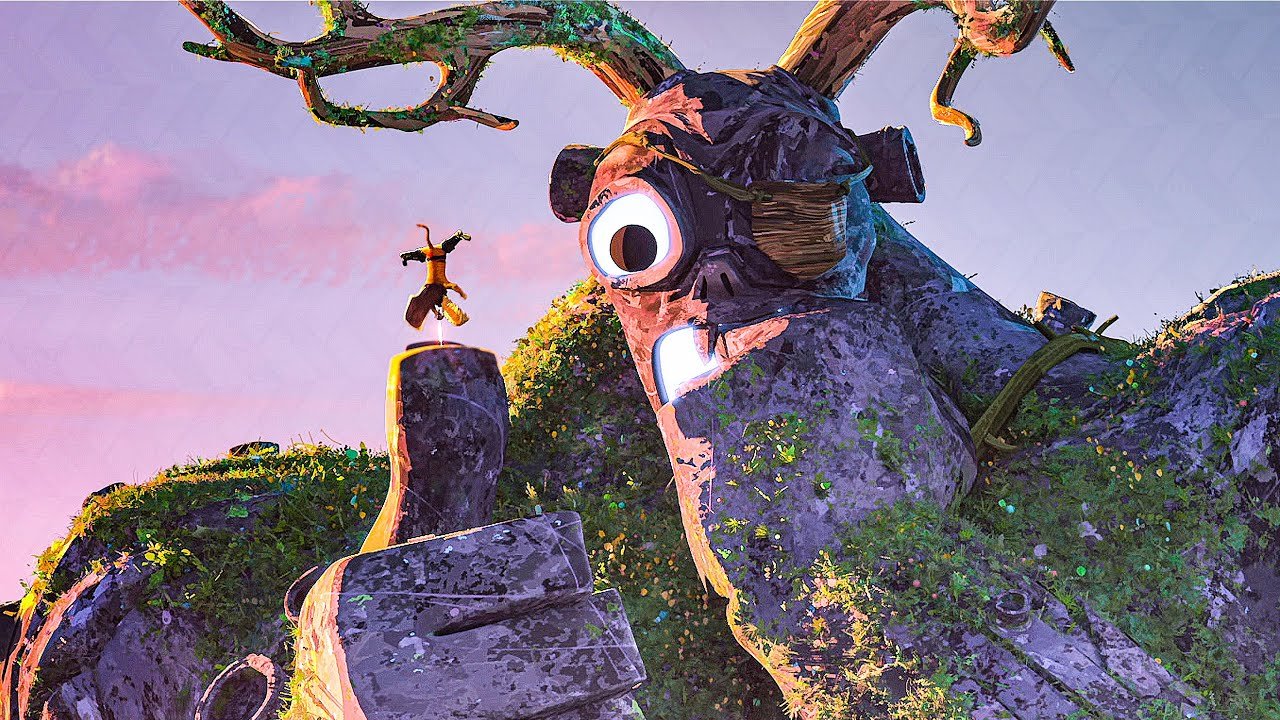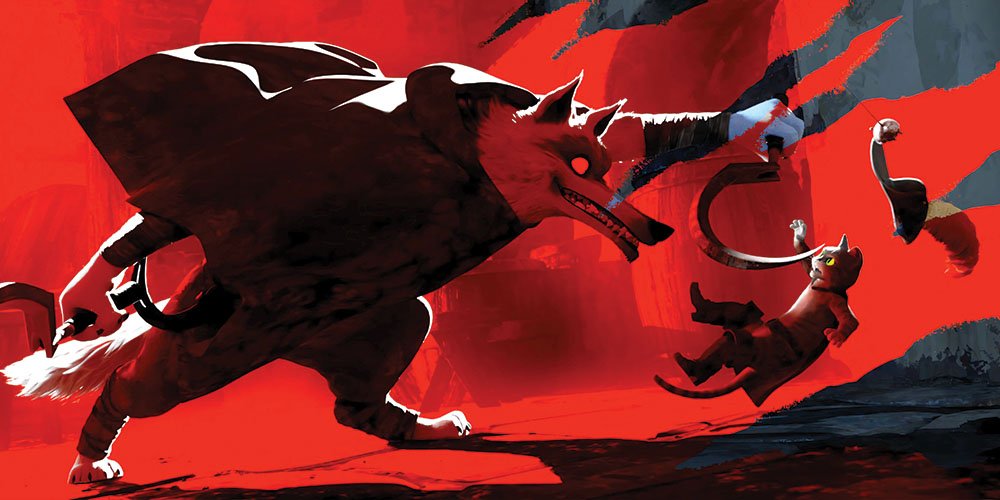Meowing in the face of Death
How can a sequel to a middling spin-off to an animated series started more than 20 years ago have any mileage? The answer: make a film like Puss in Boots: The Last Wish — the most pleasant cinematic surprise of 2023. Since the biting 2001 smash-hit, the Shrek franchise had been slowly running out of steam on the refreshingly-wry-treatment-of-fairy-tales front. Joel Crawford and Januel Mercado’s offering isn’t just some more steam: it’s a whole new engine.
In The Last Wish, we see a Puss coming to the end of his glory days, having reached the final of his nine lives, forced to hang up the cape in the face of literal Death, a gleefully relentless (and terrifying) wolf (Wagner Moura). He feels the call to action when he catches wind of a map to a star that can grant a single wish to the one who finds it: can he find a way to cheat death? Also after the star are the ‘big’ Jack Horner (John Mulaney on fine form), equipped with an arsenal of weaponised magic, the so-called ‘crime syndicate’ of Goldilocks (Florence Pugh) and the Three Bears (Olivia Colman, Ray Winstone and Samson Kayo), and Puss’ past compatriot Kitty Softpaws (Salma Hayek).
On the page, this already sounds like an overstuffed story, but the film manages to avoid tripping over its own subplots. This is in part because The Last Wish feels, in the best possible way, like Dreamworks’ answer to Sony’s 2018 smash-hit Into the Spider-Verse. 2022’s The Bad Guys was the preamble of this answer, but this helping is the real thing. This is no doubt partly Bob Persichetti’s influence (one of the creative directors of Spider-Verse, who was set to helm The Last Wish until he was replaced by Crawford in 2021). Production designer Nate Wragg’s suggestion of a “storybook” style of animation was also clearly taken on board.
That’s no windmill. Puss in Boots: The Last Wish (©DreamWorks, 2022)
From the start, The Last Wish is gorgeous to look at. The opening episode, featuring Puss dispatching a stone giant in a quaint Spanish town, is the kind of sequence we could imagine Don Quixote is carrying out in his own mind when tilting at windmills. It’s unbridled joy, heralding a creative use of lowered frame rates and dazzlingly bright brushstrokes of colour. As another reviewer has noted, the runaway success of Disney’s 3D animation of the late ‘90s to early 2000s has led to some cookie-cutter visual effects styling for animation— and films like The Last Wish continue to show that creative departures are always welcome, that animation is a medium with yet-untapped potential.
Banderas is still clearly having the time of his voice-acting career voicing Puss. It’s no secret that his performance in The Mask of Zorro was a direct inspiration for the character’s first appearance in Shrek 2; his performance as Puss since then has never really missed a beat. Banderas’ own experience of a heart attack in 2017 has served as a direct inspiration for the more intense emotional journey that Puss embarks on in The Last Wish.
The desire for a darker story about Puss has led to a highly refreshing show of mental health literacy in a film nominally aimed at children. That Puss is forced to confront his own mortality is both a continued theme in the film and the grounds for an excellent, realistic depiction of a panic attack. The instigator of this conflict is Moura’s Death, for many the scene-stealer of the film. Already celebrated as an excellent on-screen villain, Death hounds Puss throughout the film (appearing to the anxious Puss where he is not), seeking to strip him of his arrogance and self-proclaimed hero status. Puss’ identity enters crisis mode when he realises he is not, in fact, able to “laugh in the face of Death”.
A lot comes together for the success of lobo-Death as a villain. His introduction is flawless, employing the classic tactic of transferring all the hero’s good qualities to the main antagonist. With a creepy whistle-tune inspired from spaghetti westerns, he appears next to Puss in a quiet bar, menaces him, and completely overpowers him. He is faster, stronger, and calmer than Puss in their initial conflict, and strikes at the heart of what Puss has valued most up this point in his lives. Puss continues to be haunted by visions of the wolf (the cause of his panic attack) until he realises what is truly important to him by the end of the film.
If this sounds like it’s scary, it is. Even more so than the other franchise entries, this film really does not shy away from straightforward horror tropes — namely a slasher-movie moment where Death’s shadow looms over Puss in a locked room. Crawford and Mercado are clearly looking to avoid condescending to the children in the film’s audience in favour of pursuing a narrative that will deal with Puss’ deepest fears honestly. To introduce genuine scares is to pave the way for a more satisfying emotional resolution, which we see when Puss finally overcomes not only his fear of mortality, but his fear of abandonment (which he shares with Kitty Softpaws).
Puss finally meets his match. Puss in Boots: The Last Wish (©DreamWorks, 2022)
The two main antagonists of the film end up being highly complementary to each other. Jack Horner is overblown and comical, unabashed in his maliciousness (as we see when, in one of the best running gags of the film, Jiminy Cricket fails miserably to reform Jack’s morals). He is uncomplicatedly evil, and goes out on a gloriously silly meta-pun. We are never supposed to take him seriously as a threat to the main characters. He is at most a physical obstacle for the plot, while Death is an emotional one, blocking the path for our main protagonist by instilling a paralysing fear.
Death is not alone in being a well-executed foil for Puss. Harvey Guillén manages to inject self-proclaimed therapy dog Perrito, the character most ostensibly orientated as comic relief for a younger audience, with enough charm to avoid a wholly grating presence. (Christy Lemire goes so far as to say that Guillén’s performance is the “unexpected highlight” of a stacked voice cast). This is because Perrito’s quips about the present moment and gratitude for life, initially cloying, serve a deeper purpose to counter Puss’ own flawed attitude to his sense of self. Puss is obsessed with crafting the perfect heroic image, and is made to realise that the result of this pursuit is loneliness.
All the above convinces me that Peter Bradshaw watched a different film for his review. He calls it “bland and forgettable”, and the kind of film that’s been churned out of “some giant IBM-style computer” (despite the fact that this project was stuck in development hell since 2012). While some of the building blocks of The Last Wish are formulaic — the adorkable best friend, Goldilocks’ chosen-family strife, Softpaws’ trust issues — Bradshaw’s criticism misses the mark entirely. It is a far cry from being generic, with a smart script, a mature approach to mortality, and a clear love for the craft.
There are a couple of weak points. At times the interactions with fairy tale paraphernalia feel less charming (as they consistently do in the first two Shrek films), and more like a barrage. Florence Pugh going cockney for her Goldilocks was also a slightly unfortunate touch (to chime, only once, with Bradshaw). Much as her stardom is well deserved (she really was that good in Midsommar), her contribution here feels a little forced. There are only so many times we want to hear her and the bears discuss what is and isn't ‘Jast Roight’.
The only other minor gripe is less to do with The Last Wish as a film, and more with the novel Dreamworks logo that will accompany their new films for the foreseeable future. In what seems to be yet another fumbling effort to replicate the success of Marvel’s cinematic ‘universe’, the Dreamworks boy departs from fishing on the moon and takes a whistle-stop tour to greet the studio’s ‘most iconic’ characters (noticeable absences include Megamind). Put simply, nothing about this new logo feels right.
But these downsides are far outweighed by the film’s resounding success in speaking to a double audience of children and adults (exurb2a’s take on this is well worth a listen.) Guillermo del Toro has replicated this success with his Pinocchio, also a film with an unflinching treatment of death and mortality, which took home the Oscar this year over The Last Wish.
Addressing young and old alike is common both to the Shrek franchise and to the roots of the stories which the films develop. Folk tales communicate a ‘moral’ which may be absorbed by children, adults, or both (more on this in the footnote). On-screen stories develop their moral in a different way, but within the text of The Last Wish are multiple lessons that Puss — with a dual adult-child audience alongside him — learns quite explicitly. Perrito is the moral messenger of the film, with such platitudes as “I’ve only ever had one life, but sharing it with you and Kitty has made it pretty special. Maybe one life is enough.” He would be an irritating character if what he expresses did not meaningfully transform his companions.
What a treat it is to see the spirit of the original Shrek film sustained, and perhaps even improved, in a spin-off more than twenty years on. In the right hands, updating folk tales for a modern audience still has a lot of mileage. The Last Wish is a triumph in its medium, bursting with style, substance, and genuine feeling.
Footnote: Puss’s Roots
Talking animals feature in the oldest parts of the western literary canon (Achilles’ horse Xanthus speaks to him in Homer’s Iliad). The (slightly more recent) original Puss in Boots is the most famous example of the ‘animal as helper’ archetype from the Aarne-Thompson-Uther (!) Tale Type Index. He first appears in Straparola’s 1550 collection of fairy tales, Facetious Nights of Straparola. The story was adapted further in Giambattista Basile’s (1634) and Perrault’s (1697) versions. Common to all the stories is a young man left a cat as his only inheritance, who helps his new master marry a king’s daughter by convincing everyone that the master is in fact an illustrious count. The folk tale also features Puss outwitting and killing an ogre — hence why he is introduced as an ‘ogre killer’ in Shrek 2. They really did their research.
It is a little difficult to unearth the moral of the story of Puss in Boots — in Straparola’s version especially, Puss and his master seem to benefit from a long stroke of luck, instead of hard work or upstanding behaviour. Perrault’s moral is mainly that appearance matters; a more general angle could be that one should appreciate the gifts one is given, as they may be more than they first appear.
Puss in Boots has also been on screen for over a hundred years. The 1922 silent Disney short is a more ‘traditional’ treatment of the Perrault material, replete with young master, king and daughter. Toei Animation’s famous mascot is its own Puss, from its successful 1969 rendition (iMDB amusingly credits Perrault himself as one of the writers for the film). There are some Dumas-musketeer elements to this film, as well as the beginnings of Puss as more of a Robin Hood figure saving mice.
Toei Animations’ Puss in Boots (1969)
Banderas’ Puss, then, is a lot more independent than the original character who acts ultimately in his master’s interest (much like the cunning slaves of Plautine comedies). For Shrek 2, Puss began to be modelled off multiple lone wolf-esque characters. Banderas’ own Zorro, as mentioned above, was a large influence, as were the iconic screen presences of Clint Eastwood, and even Indiana Jones.


